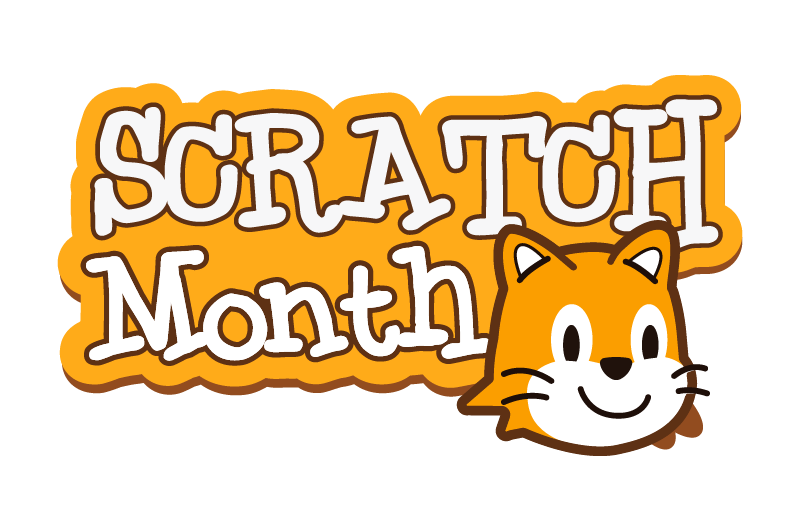
VIII Scratch Month Porto 2022
Here comes a month full of activities for you to learn programming and celebrating Scratch!
From May
2 to 27
VIII Scratch Month Porto 2022
Here comes a month full of activities for you to learn programming and celebrating Scratch!
From May
2 to 27


Scratch is Imagination Programming Learning Sharing

A day full of activities
Scratch Day is a scheduled day with numerous activities for all ages. Come to learn and celebrate with us 15 years of creation of the Scratch programming language.
Participe no dia
Take part in May 21

Workshops and activities
Schedule for the 21st of May
Workshops for Primary and Middle School
1º ano
Escape Room with Scratch
A dynamic Escape Room type where students will decipher puzzles to get around the spaces and look for a way out. The activity will be even funnier with the final challenge that invites students to create an animation with the Scratch kitten and, with that, leave the environment.
2º e 3º anos
Learn Scratch!
In space learn Scratch! Students will be challenged to create animations and games through cards with programming blocks. In this workshop, student tutors will lead the activities and share their experiences.
4º e 5º anos
Programming with sensors in Scratch
In this workshop, students will program and control characters in Scratch through interactive sensors of lego WeDo kits.
6º e 7º anos
Workshop: soccer video sensing
Game of player interaction with virtual characters using the camera extension (video sensing). The objective of the game is not to let the characters that fall from the sky reach the ground (bottom of the screen).
8º e 9º anos
Obstacle race
Team challenge: assemble a physical robot structure using Lego ev3. Program the robot in Scratch so that it can follow a path with obstacles and challenges, and reach the end of the route.
Todos os níveis
Free Activity: Super Mario Bros in Scratch
Students will be invited to play the classic Super Mario Bros. developed entirely in Scratch. For this, everyone will have to use a joystick with a microcontroller board.
Ensino Fundamental II
Mundo 4D
Maze Run
In this activity students will have to use their logic and math skills to build a program in block language (inspired by Scratch) to make their Spark Robot escape a maze!
Ensino Fundamental I e II
SOMAI
DASH CHALLENGE - Programming is fun!!!
Come learn and have fun using technology and programming. In this workshop we will use Robot Dash to solve various challenges. Knowledge, fun and technology together. We wait for you!
Ensino Fundamental I
Mundo Maker
Oficinas oferecidas por parceiros. O tema será anunciado em breve.
Workshops for Parents and Teachers
from 9am to 10am
School teachers
Scratch DJ - Sensitization and mixing
We will present to teachers how to use the tool both in terms of technical aspects (such as simple navigability) and creative aspects to develop animations and games.
from 10am to 11am
Parents and Guardians
Scratch 3.0 - Game Factory for Parents
In this workshop we will present games and activities from the Scratch platform to be remixed and produced by families.

Activities and Workshops
They are held during the period of classes either in the International and Bilingual Curriculum for the Morumbi Valinhos and Panamby Campuses.
Live Aula Magna
12/05
Primary and Middle School
Live for the 15th Anniversary of Scratch
Scratch: programming as learning content
Playroom at break time
Primary and Middle School
Binary Scratch
In this activity students will be playfully challenged to transform decimal numbers into binary ones.
Primary and Middle School
Scratch Maze
Using direction signs, learners will guide the Scratch cat through the maze mentally planning the shortest route.
Primary and Middle School
Indigenous boardgame in Scratch
Adaptation of the traditional indigenous boardgame “the jaguar game”
Primary and Middle School
Scratch Race
Track game in which learners will follow the path using concepts of computational thinking.
Primary
Activities which will be carried out during the Digital Literacy classes
Year 1
Scratch offline
In this game, learners will work in teams and will be challenged to advance squares in a digital boardgame, following teacher’s instructions.
Year 2
Scratch Jr.
The challenge of this activity will be to program a sequence of movements for a character to climb the stairs to reach the podium.
Year 3
Lego WeDo
+ Scratch
Conceitos de robótica como eixos e polias serão abordados nesta sequência de atividades por meio da montagem de um protótipo com o Lego WeDo e programação no Scratch.
Year 4
Studio Scratch
Students will program games using sensors and variables. For this, they will have to insert characters, scenarios and objects.
Year 5
Scratch for Arduino (S4A)
Merging virtual and physical programming, students will assemble electronic circuits with the microcontroller board, LEDs and resistors and with Scratch for Arduino (S4A), developing a voting system for a Quiz game.
Middle School
Activities carried out during the Digital Literacy classes.
Year 6
Game Factory Scratch
In this activity we will use Scratch to develop free themed digital games exploring the concept of variables in order to produce a scoring system.
Year 7
Robótica + Scratch
We will work with a robotics kit, from an extension of Scratch, with the purpose of building and programming inclusive robots, which can help people with disabilities in different daily tasks.
Year 8
8 Magic Ball + Scratch
In this activity, we will use the concept of the 8 Magic Ball toy related to randomness to execute the commands of the Scratch platform, thus converting analog functionalities to digital through computational thinking.
Year 9
EV3 + Scratch
In this activity we will use the ev3 kit to be commanded through the Scratch platform.
In this way, we will develop playful challenges that use both the mechanisms of EV3 and the resources of Scratch.
Digital Information and Communication Technologies
Teaching training cycle
16/05
Scratch Jr
We will present to teachers how to use the tool both in terms of technical aspects (such as simple navigability) and creative aspects to develop animations and games.
23/05
Scratch 3.0
Teachers will browse the Scratch platform to get acquainted with the games and animations that exist there and will also develop a creation for planning teaching and learning activities.
30/05
Scratch with microcontroller boards
Scratch’s versatility goes beyond making animations and games, it can also be used for functional prototypes applicable in Maker projects and itineraries.
Activities at Vila Andrade Campus
Held during the class period
Primary
Activities carried out during Digital Literacy classes
Year 1
Knowing commands with Scratch
In this game, students will work in teams and will be challenged to advance spaces on a digital board, following the teachers’ guidelines. Each group will follow the steps and activities that appear along the trail, creating a board at the end.
Year 2
With Scratch Jr I create an animation
Create an animation by inserting a scenario and at least two actors. Use the commands necessary for the kitten to reach the other actor (of your choice) and using the recording feature, make a small dialogue.
Challenge: enter more than one scenario.
Year 3
My friend and I animating on Scratch Jr
Create an animation by inserting scenarios and two actors (You and a friend) so you can use the photo and speech bubbles feature. Use the command blocks necessary for the animation.
Year 4
Unleashing the imagination in Scratch
Display an animation with the initial letter of your name.
With resources explored and others to be discovered, challenging students to unleash their imagination.
Year 5
Remixing an idea
Search for a game in the Scratch project bank with a sports theme. From this choice, the student must remix the project and create their own game.
Middle and High School
Activities carried out during Digital Literacy classes
6º ano
Scratch com placa de prototipagem
Explore programming resources to create fun projects using Makey Makey in Scratch. Series project theme: sustainability – caring for the health of the planet
7º ano
Programando para inclusão com Scratch
Game for the visually impaired using the text to speech extension, the game will have to have sound and information of all game objectives in real time.
Series project theme: inclusion – valuing diversity
8º ano
Do físico ao digital
In this activity we will use the concept of the 8 Magic Ball toy related to randomness to execute the commands of the Scratch platform, thus converting analog to digital functionalities through computational thinking.
9º ano
Arduino e Scratch
Explore options for using Arduino with Scratch resources. Source of inspiration:
2ª série do Ensino Médio
EV3 com Scratch
Connect Lego Mindstorm EV3 to Scratch platform / inspiration:
In this activity we will use the ev3 kit to be commanded through the Scratch platform.


Morumbi and Valinhos' Theme: Where is Visconde?
Panamby's Theme: THE JOURNEY OF FRITZ MÜLLER
The legacy of naturalist Fritz Müller reaches its bicentennial. The biologist and physician is being honored with the exhibition “Fritz Müller: Prince of the Observers”, prepared by the Martius-Staden Institute as part of the celebrations. A pioneer in the factual support for Charles Darwin’s theory of evolution, with relevant research in the field of botany and zoology, collaborating in the proof of the theory of evolution of species, Fritz Müller left an incredible legacy.
Throughout the Game Jam, students will be challenged to create a game from a proposal.
Get to know more about the event:
About Scratch

With Scratch, you can program your own games, animations, and interactive stories — and share your creations with others in the online community.
Scratch helps young people learn to think creatively, reason systematically, and work collaboratively—essential skills for life in the 21st century.
Scratch is a project of the Lifelong Kindergarten group at MIT’s Media Lab. It is available free of charge.
Previous years
2021

2020

2019



